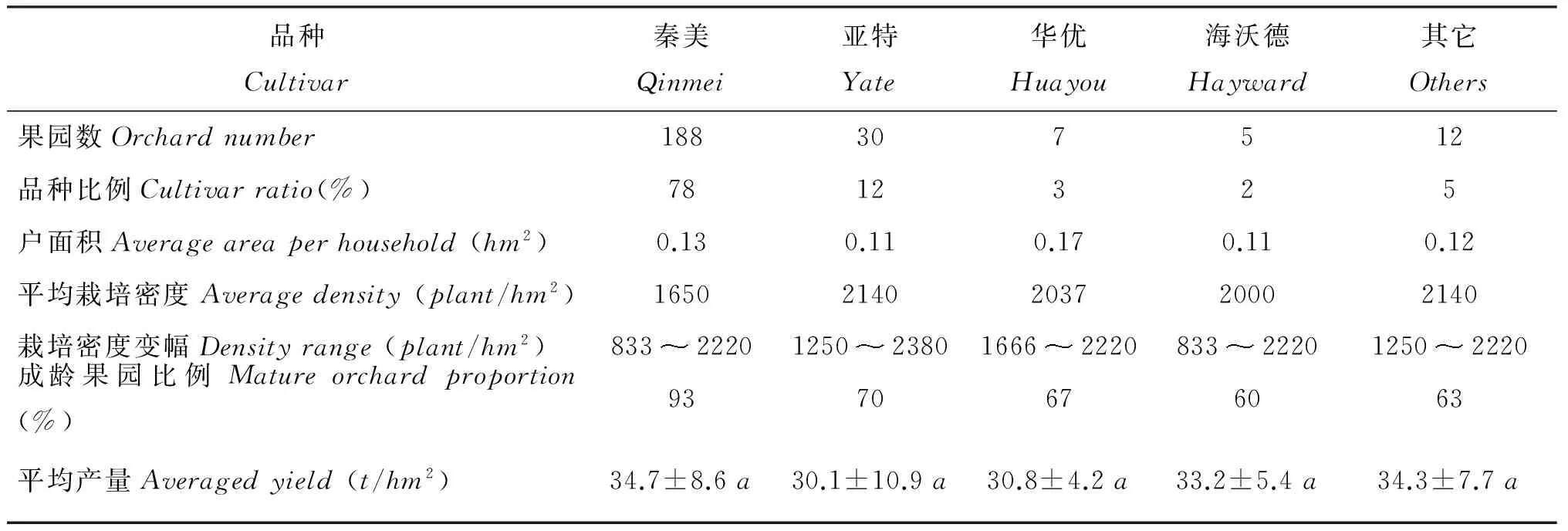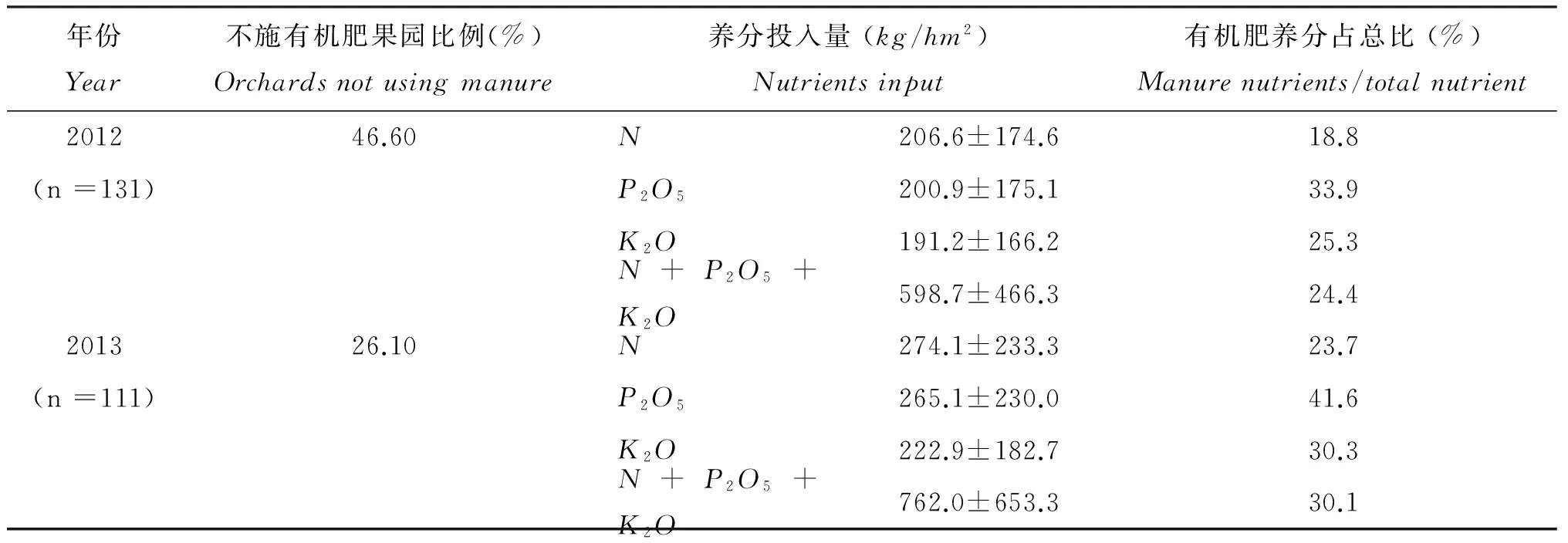秦岭北麓猕猴桃果园施肥现状与评价
2016-08-24路永莉康婷婷张晓佳高晶波陈竹君周建斌
路永莉, 康婷婷, 张晓佳, 高晶波, 陈竹君, 周建斌*
(1西北农林科技大学资源环境学院, 陕西杨凌 712100; 2农业部西北植物营养与农业环境重点实验室,陕西杨凌 712100)
秦岭北麓猕猴桃果园施肥现状与评价
—以周至县俞家河流域为例
路永莉1,2, 康婷婷1,2, 张晓佳1,2, 高晶波1,2, 陈竹君1,2, 周建斌1,2*
(1西北农林科技大学资源环境学院, 陕西杨凌 712100; 2农业部西北植物营养与农业环境重点实验室,陕西杨凌 712100)

秦岭北麓; 猕猴桃; 施肥现状; 果园

俞家河流域是秦岭北麓典型的山丘地带,又是猕猴桃种植密集区,果园养分投入量普遍偏高[6-7],加之该区域土壤多发育于山前洪积扇,耕地坡度大,同时降雨充沛,灌溉便捷,容易造成水、土资源和养分的大面积流失,成为农业面源污染高风险区。因此,掌握该流域猕猴桃果园的实际生产现状,可为果园养分优化管理和农业面源污染防治提供理论基础。
1 材料与方法
1.1研究区概况


图1 俞家河流域土地利用现状Fig.1 The situation of land use in Yujia river catchment
1.2调查方法与项目
1.3肥料养分计算
化肥养分含量根据实际调查的果园施肥量和各肥料产品中标注的养分含量计算获得; 有机肥养分含量按《中国有机肥养分志》提供的标准值[8]计算。
1.4数据处理
数据整理和统计分析采用Excel2007和SAS9.0进行,图形的绘制采用SigmaPlot12.0软件进行。
2 结果与分析
2.1猕猴桃园概况


表1 俞家河流域猕猴桃果园的基本情况
2.2猕猴桃果园养分投入现状
2.2.1 有机肥施用状况连续两年调查结果表明,研究区猕猴桃果园有机肥投入严重不足(表2)。其中,2012年约有46.6%的果园未施用有机肥,2013年该比例虽有所下降,但仍有26.1%的果园未施用有机肥。另外,从有机肥所提供的养分量(指施用有机肥果园的平均值)来看,2012年果园有机肥总养分(N+P2O5+K2O)投入量为598.7kg/hm2,占果园总养分投入量的24.4%,其中N、P2O5和K2O养分投入量分别为206.6kg/hm2、200.9kg/hm2和191.2kg/hm2。2013年果园有机肥总养分投入量较2012年有所增加,为762.0kg/hm2,占果园总养分投入量的30.1%,其中N、P2O5和K2O养分投入量分别为274.1、265.1和222.9kg/hm2。

表2 2012和2013年研究区猕猴桃园有机肥养分投入量 (kg/hm2)

由图2同时可知,2013年化肥氮、磷和钾养分平均投入量较2012年均有所下降,分别从N898kg/hm2、P2O5401kg/hm2和K2O597kg/hm2下降为N884kg/hm2、P2O5372kg/hm2和K2O521kg/hm2,这可能是因为2012年调查结束后,我们立即对调查数据进行了汇总、整理和分析,并将果园施肥现状评价结果及时反馈于各户果农,建议果农可以在来年施肥中降低果园的化肥投入量。
2.3猕猴桃产量与施肥量的关系
将连续两年调查的果园肥料养分投入量进行分级,并统计了对应的果实产量水平(图3)。结果表明,随着化肥氮、磷和钾养分投入量的增加,果实产量呈现先增加后保持不变或先增加后降低的趋势,说明化肥养分投入整体上表现出报酬递减的规律。

图2 2012年(n =131)和2013年(n =111)流域内猕猴桃果园化肥氮、磷、钾养分投入量Fig.2 N, P2O5 and K2O inputs from chemical fertilizer in Yujia river catchment in 2012 (n=131) and 2013 (n=111)
[注(Note): 矩形盖中间实线和虚线,上、下边框,箱外的上下边缘和点分别代表中位数和平均值,全部数值的25%,75%,5%,95%分值。Thesolidanddashedlines,lowerandupperedges,barsanddotsinoroutsidetheboxesrepresentmedianandmeanvalues, 25thand75th, 5thand95th,and<5thand> 95thpercentilesofalldata,respectively.]



图3 猕猴桃果园化肥不同投入水平下的产量和果园样本分布频率Fig.3 Frequency distribution of yield and samples in the investigated orchards under different levels of chemical fertilizer input to kiwifruit orchards
2.4研究区猕猴桃果园施肥状况评价

2.4.2 猕猴桃施肥量分级标准的确定在果园合理施肥量的基础上(表3),根据养分投入量的分级方法和原则[7],将小于合理用量50%定义为“过低”, 大于合理用量50%为“过高”,“合理”与“过低”之间为“偏低”,“合理”与“过高”之间为“偏高”。依据这一分级标准,秦岭北麓猕猴桃果园施肥用量分级结果如表4。

表3 俞家河流域猕猴桃果园合理施肥量

表4 俞家河流域猕猴桃果园施肥量分级标准
2.4.3 猕猴桃园施肥状况评价根据表4确定的猕猴桃果园施肥量分级标准,对秦岭北麓俞家河流域猕猴桃果园化肥和有机肥养分投入量进行总体分析与评价(图4)。由图4可知,化学氮肥投入合理比例仅为5.0%,过量比例高达81.8%。其中,氮肥投入过高(超过750kg/hm2)的比例占59.1%,氮肥平均过量454kg/hm2,说明该区域猕猴桃果园氮肥投入过量现象非常严重; 磷肥投入合理的比例为19.4%,不足及过量比例分别为28.9%和51.7%,其中,偏低和偏高比例分别为12.8%和36.8%,可见科学引导果农施用磷肥也是该流域猕猴桃果园养分优化管理的重要内容之一; 钾肥投入合理比例仅占10.7%,不足比例为30.6%,过量比例高达58.7%,因此,提倡果园增施钾肥应分区进行,不能一概而论,应合理引导并适当控制钾肥投入。有机肥用量评价结果显示,研究区果园有机肥投入严重不足,不足比例高达94.3%。同时,从图4中可以看出,2012年和2013年研究区果园各养分投入量分级比例基本保持一致。

图4 2012年和2013年俞家河流域猕猴桃果园各养分不同投入水平所占比例Fig.4 Percentage of nutrient input levels in the kiwifruit orchards in Yujia river catchment in 2012 and 2013
3 讨论

3.1有机肥投入严重不足

3.2盲目追求高产,化肥施用过量现象非常普遍
3.3过量施肥的潜在环境威胁

4 结论
秦岭北麓俞家河流域猕猴桃果园有机肥投入严重不足。其中完全不施用有机肥的果园占36.4%。即使在施有机肥的果园中,亦有94.3%的果园有机肥投入严重不足,且提供养分的比例不足总养分的30%。化肥养分中,氮肥投入过量现象非常普遍,纯氮施用量超过750kg/hm2的果园比例高达59.1%; 磷、钾肥过量和不足现象并存,其中过量比例分别为51.7%和58.7%。因此,在今后该区域果树施肥实践中,应大力增加有机肥投入量和施用比例,大幅度降低氮肥投入量,同时合理引导磷、钾肥的科学施用。另外,因研究区特殊的地形特征,优化养分管理和减少养分损失带来的农业面源污染问题也是今后应重点研究的问题。
[1]陕西省统计局. 2012年陕西省果业发展统计(监测)公报[EB/OL].http: //esb.sxdaily.com.cn/shtml/sxrb/20130402/198111.shtml.
B©ureauofStatisticsofShaanxi.In2012,theShaanxiprovincialfruitindustrydevelopmentstatisticsbulletin(monitoring) [EB/OL].http: //esb.sxdaily.com.cn/shtml/sxrb/20130402/198111.shtml.
[2]来源, 同延安, 陈黎岭, 等. 施肥对猕猴桃产量和品质的影响[J]. 西北农林科技大学学报(自然科学版), 2011, 39(10): 171-176.
LaiY,TongYA,ChenLL, et al.Effectoffertilizationonkiwifruityieldandquality[J].JournalofNorthwestA&Funiversity(Nat.Sci.Ed.), 2011, 39(10): 171-176.
[3]别智鑫, 翟梅枝, 李春茂, 等. 不同施肥处理对“秦美”猕猴桃贮藏性及其品质的影响[J]. 西北植物学报, 2006, 26(9): 1950-1954.
BieZX,ZhaiMZ,LiCM, et al.Influenceoffertilizationonpost-harveststorageandqualityofActinidia chinensisfruits[J].ActaBotanica-OccidentaliaSinica, 2006, 26(9): 1950-1954.
[4]闫亚舟, 徐福利, 邹诚, 等. 黄土高原坡地苹果园土壤肥力及矿质氮累积分析[J]. 水土保持通报, 2009, 29(4): 31-36.
YanYZ,XuFL,ZouC, et al.SoilfertilityandmineralNaccumulationofslopeappleorchardontheLoessPlateau[J].BulletinofSoilandWaterConservation, 2009, 29(4): 31-36.
[5]赵佐平, 闫莎, 刘芬, 等. 陕西果园主要分布区氮素投入特点及氮负荷风险分析[J]. 生态学报, 2014, 34(19): 5642-5649.ZhaoZP,YanS,LiuF, et al.AnalysisofnitrogeninputsandsoilnitrogenloadingindifferentkindsoforchardsinShaanxiProvince[J].ActaEcologicaSinica, 2014, 34 (19): 5642-5649.
[6]刘侯俊, 巨晓棠, 同延安, 等. 陕西省主要果树的施肥现状及存在问题[J]. 干旱地区农业研究, 2002, 20(1): 38-44.
LiuHJ,JuXT,TongYA, et al.ThestatusandproblemsoffertilizationofmainfruittreesinShaanxiProvince[J].AgriculturalResearchintheAridAreas, 2002, 20(1): 38-44.
[7]王小英, 同延安, 刘芬, 等. 陕西省苹果施肥状况评价[J]. 植物营养与肥料学报, 2013,19(1): 206-213.
WangXY,TongYA,LiuF, et al.EvaluationofthesituationoffertilizationinapplefieldsinShaanxiprovince[J].PlantNutritionandFertilizerScience, 2013, 19(1): 206-213.
[8]全国农业技术推广服务中心. 中国有机肥料养分志[M]. 北京: 中国农业出版社, 1999. 2-194.
NationalAgriculturalTechnologyExtensionandServiceCentre.Chinaorganicfertilizerrecords[M].Beijing:ChinaAgriculturePress, 1999, 2-194.
[9]同延安. 北方果树测土配方施肥技术[M]. 北京: 中国农业出版社, 2011, 01
TongYA.ThefruittreessoiltestingandfertilizationrecommendationinNorthChina[M].Beijing:ChinaAgriculturePress, 2011. 01.
[10]王建. 猕猴桃树体生长发育, 养分吸收利用与累计规律[D].陕西杨凌: 西北农林科技大学硕士学位论文, 2008.
WangJ.Thegrowth,nutrientuptake,utilizationandaccumulationinkiwifruittree[D].Yangling:Shaanxi,ThesisforMasterDegree,NorthwestA&FUniversity, 2008.
[11]乔继宏, 张 斌, 杨苏鲜. 户县猕猴桃测土配方施肥技术[J]. 中国农技推广, 2009, 25(10): 41-42.
QiaoJH,ZhangB,YangSX.ThekiwifruittreessoiltestingandfertilizationrecommendationinHuxiancounty[J].ChinaAgriculturalTechnologyExtension, 2009, 25(10): 41-42.
[12]张福锁, 陈新平, 陈清. 中国主要作物施肥指南[M]. 北京: 中国农业大学出版社, 2009. 84-87.
ZhangFS,ChenXP,ChenQ.FertilizationguideonmajorcropsofChina[M].Beijing:ChinaAgriculturalUniversityPress, 2009. 84-87.
[13]刘旭峰. 猕猴桃栽培新技术[M]. 陕西杨凌: 西北农林科技大学出版社, 2005.
LiuXF.Newcultivationtechniquesofkiwifruit[M].Yangling:NorthwestA&FUniversitypress, 2005.
[14]姜远茂, 张宏彦, 张福锁, 等. 北方落叶果树养分资源综合管理理论与实践[M]. 北京: 中国农业大学出版社, 2007.
JiangYM,ZhangHY,ZhangFS, et al.Thetheoryandpracticeofintegratedmanagementofnutrientresourcesinnortherndeciduousfruittrees[M].Beijing:ChinaAgriculturalUniversityPress, 2007.
[15]王圣瑞. 陕西省与北京市主要作物施肥状况与评价[D]. 北京: 中国农业大学博士学位论文, 2002.
WangSR.CurrentstatusandevaluationofcropfertilizationinShaanxiprovinceandBeijingcity[D].Beijing:PhDDissertation,ChinaAgriculturalUniversity, 2002.
[16]王允圃, 刘玉环, 阮榕生, 等. 有机肥改良农产品品质的科学探索[J]. 中国农学通报, 2011,27(9): 51-56.
WangYP,LiuYH,RuanRS, et al.Studyontheeffectoforganicmanureonimprovingthequalityoffarmproducts[J].ChineseAgriculturalScienceBulletin, 2011, 27(9): 51-56.
[17]赵佐平, 高义民, 刘芬, 等. 化肥有机肥配施对苹果叶片养分、品质及产量的影响[J]. 园艺学报, 2013, 40(11): 2229-2236.
ZhaoZP,GaoYM,LiuF, et al.Effectsoforganicmanureapplicationcombinedwithchemicalfertilizersontheleafnutrition,qualityandyieldoffujiapple[J].ActaHorticulturaeSinica, 2013, 40(11): 2229-2236.
[18]马国瑞. 园艺植物营养与施肥[M]. 北京: 中国农业出版社,1994.123-156.
MaGR.Nutritionandfertilizationofhorticulturalplants[M].Beijing:ChinaAgriculturePress, 1994.123-156.
[19]JuXT,XingGX,ChenXP.ReducingenvironmentalriskbyimprovingNmanagementinintensiveChineseagriculturalsystems[J].PNAS, 2009, 106(9): 3041-3046.
[20]吕殿青, 同延安, 孙本华. 氮肥施用对环境污染影响的研究[J]. 植物营养与肥料学报, 1998, 4(1): 8-15.
LvDQ,TongYA,SunBH.Studyoneffectofnitrogenfertilizeruseonenviromentalpollution[J].PlantNutritionandFertilizerScience, 1998, 4(1): 8-15.
[21]薛利红, 杨林章, 施卫明, 等. 农村面源污染治理的“4R”理论与工程实践—源头减量技术[J]. 农业环境科学学报, 2013, 32(5): 881-888.
XueLH,YangLZ,ShiWM, et al.Reduce-retain-reuse-restoretechnologyforcontrollingtheagriculturalnon-pointpollutionincountrysideinChina:Sourcereductiontechnology[J].JournalofAgro-EnvironmentScience, 2013, 32(5): 881-888.
[22]常志州, 黄红英, 靳红梅, 等. 农村面源污染治理的“4R”理论与工程实践—氮磷养分循环利用技术[J]. 农业环境科学学报, 2013, 32(10): 1901-1907.
ChangZZ,HuangHY,JinHM, et al.Reduce-retain-reuse-restoretechnologyforthecontrollingtheagriculturalnon-pointsourcepollutionincountrysideinChina:reuseofnitrogenandphosphorousinagriculturalwastes[J].JournalofAgro-EnvironmentScience, 2013, 32(10): 1901-1907.
[23]施卫明, 薛利红, 王建国, 等. 农村面源污染治理的“4R”理论与工程实践—生态拦截技术[J]. 农业环境科学学报, 2013, 32(9): 1697-1704.
ShiWM,XueLH,WangJB, et al.Areduce-retain-reuse-restoretechnologyforcontrollingruralnon-pointpollutioninChina:Eco-retaintechnology[J].JournalofAgro-EnvironmentScience, 2013, 32(9): 1697-1704.
EvaluationofcurrentfertilizationstatusinkiwifruitorchardsonthenorthernslopeofQinlingMountains:AcasestudyofYujiahecatchment,inZhouzhiCounty
LUYong-li1,2,KANGTing-ting1,2,ZHANGXiao-jia1,2,GAOJing-bo1,2,CHENZhu-jun1,2,ZHOUJian-bin1,2*
(1 College of Resources and Environmental Science, Northwest A&F University, Yangling 712100, China;2 Key Laboratory of Plant Nutrition and the Agri-environment in Northwest China, Ministry of Agriculture, Yangling 712100, China)
【Objectives】ThenorthernsloperegionoftheQinlingMountainsissuitableforkiwifruit(Actinidia deliciosa)cultivation,andnowhasdevelopedlargeareaofKiwiorchardsinShaanxiProvince.Therefore,investigatingthecurrentnutrientinputsandtheproblemsinkiwifruitorchardsisofgreatsignificanceforincreasingfruitquality,generatingfarmers’incomeandpromotingindustrialdevelopmentinthisregion.【Methods】TheYujiaheRivercatchmentisatypicalandrelativelyisolatedcatchmentsonthenorthernslopeoftheQinlingMountains.Morethan240kiwifruitorchardsweresurveyedface-to-face,combinedwithquestionnairerecordsintwoconsecutiveyears(2012and2013).Theinvestigateditemsincludedorchardbasicsituations,plantingarea,fruitvarieties,treeages,densities,fertilizerrates,fertilizervarieties,fertilizernutrientcontent,fertilizationmethods,fruityieldandirrigation.Thenutrientinputfromchemicalfertilizersinkiwifruitorchardswerecalculatedaccordingtotheactuallysurveyedchemicalfertilizerapplicationratesandthenutrientcontentlabeledonthesefertilizers.ThenutrientinputfromorganicfertilizerwerecalculatedbasedonthestandardsprovidedbytheChineseOrganicFertilizerNutrientsRecord.Thereasonablefertilizerratesinkiwifruitorchardsweredeterminedonthebasisofourstudyincombinationwiththeregionalliteratures,andfurtherthenutrientsinputstatuswereevaluated.【Results】TheinvestigationresultsandliteraturesummarysuggestedtherecommendedfertilizerrateswereN375-500kg/hm2,P2O5186-186kg/hm2,K2O286-350kg/hm2andorganicfertilizers30000-65000kg/hm2,respectively,theN∶P2O5∶K2Oratiowasabout1 ∶0.5 ∶0.73whentheyieldsofkiwifruitsarewithin24-42t/hm2.Theactualnutrientsinputsurveysshowed:organicfertilizerarerarelyapplied,approximately36.4%oforchardsneverhaveanymanureinput;Inthekiwifruitorchardsusingorganicfertilizer,theappliedamountwereseriouslyinsufficientlyinabout94.3%oftheorchards,thenutrientprovidedbymanureswaslessthan30%ofthetotalnutrientinputs.ExcessiveapplicationofNfertilizerisverycommonwithanaverageinputofN891kg/hm2.Only5.0%oftheinvestigatedorchardsapplyreasonableamount(N375-500kg/hm2), 22.7%applyNof500-750kg/hm2,and59.1%morethan750kg/hm2.Theratiooforchardswithareasonablephosphatefertilizerinput(P2O5186-266kg/hm2)was19.4%,lowinput(P2O5<186kg/hm2)andexcessiveinput(P2O5>266kg/hm2)were28.9%and51.7%,respectively.Theorchardswithreasonablepotassiumapplicationrate(K2O286-350kg/hm2)wasonly10.7%,withlowinput(K2O<286kg/hm2)andexcessiveinput(K2O>350kg/hm2)wereupto30.6%and58.7%,respectively.【Conclusions】TheorganicfertilizerinputsinthekiwifruitorchardsintheYujiahecatchmentswasextremelyinadequate,Nfertilizersweregenerallyexcessively,andexcessiveanddeficientapplicationofphosphateandpotassiumfertilizersexistedsimultaneously.Therefore,itwasstronglysuggestedtoincreaseorganicfertilizerinputs,reducenitrogenfertilizer,strengthenthereasonableapplicationofphosphateandpotassiuminkiwifruitproductioninfuture.Thewidelydistributionofslopedcultivatedlandsinthisregionrequireoptimizingnutrientmanagementandcontrollingnutrientlossesinthefutureresearch.
NorthernslopeofQinlingMountains;kiwifruit;fertilizationcurrent;orchard
2014-09-10接受日期: 2015-04-07网络出版日期: 2015-04-21
国家“十二五”科技支撑计划项目课题(2012BAD15B04);高等学校学科创新引智计划(B12007)项目资助。
路永莉(1987—), 女, 甘肃白银人,博士研究生, 主要从事果园养分综合管理及农业面源污染防控方面的研究。
E-mail:yongli1210@126.com。* 通信作者Tel: 029-87082793,E-mail:jbzhou@nwsuaf.edu.cn
S661.1
A
1008-505X(2016)02-0380-08
